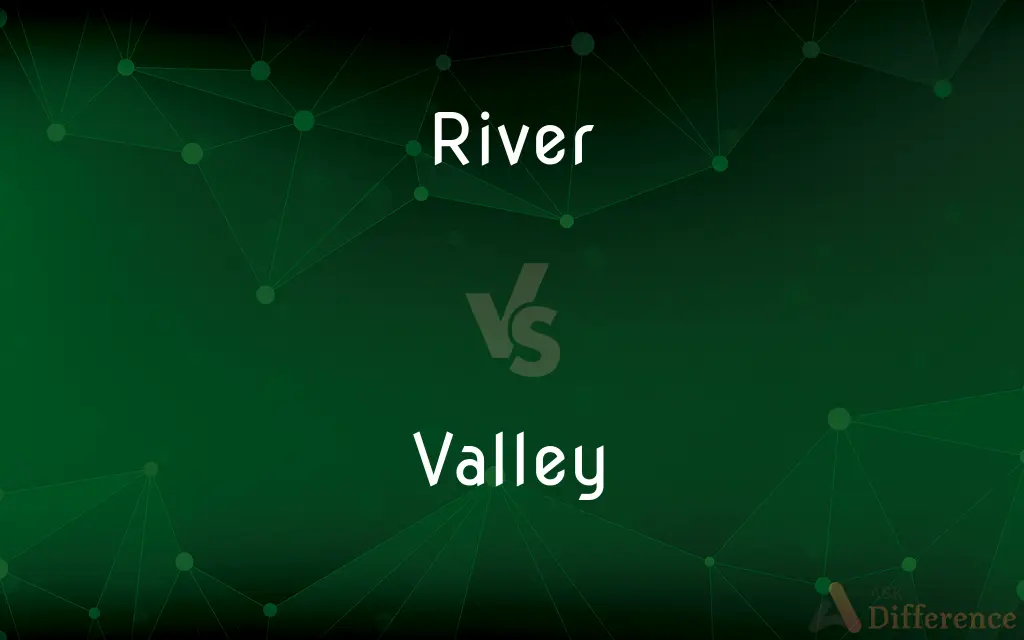River vs. Valley — What's the Difference?
By Urooj Arif & Fiza Rafique — Updated on March 6, 2024
A river is a flowing body of water, while a valley is a low area between hills or mountains, often with a river running through it.

Difference Between River and Valley
Table of Contents
ADVERTISEMENT
Key Differences
Rivers are natural watercourses, typically freshwater, flowing towards an ocean, sea, lake, or another river. They are significant sources of water for irrigation, transportation, hydroelectric power, and as habitats for many forms of life. Rivers can vary in size from small streams to vast waterways. Whereas valleys are elongated depressions in the land surface, surrounded by higher ground, formed by various geological processes including erosion by rivers, glaciers, and tectonic activity. Valleys can be categorized into several types, such as river valleys, glacial valleys, and rift valleys, depending on their formation process.
Rivers play a crucial role in shaping the earth's landscape by eroding land and depositing sediments, which can lead to the creation of valleys over geological time periods. On the other hand, valleys serve as natural pathways for rivers and streams, guiding their flow through the terrain. The interaction between rivers and valleys is a dynamic process, with rivers carving valleys deeper and wider, and valleys directing the course of rivers.
Rivers are characterized by their flow direction, discharge volume, and the ecosystem they support, including aquatic life and vegetation along their banks. Whereas valleys are defined by their shape (U-shaped or V-shaped), the surrounding topography, and the climate within the valley, which can differ significantly from the surrounding areas.
The management and conservation of rivers focus on water quality, flood control, and biodiversity preservation. In contrast, valley conservation efforts may concentrate on protecting the landscape, preventing soil erosion, and maintaining the natural habitat for wildlife.
Rivers and valleys both play vital roles in human civilization, providing water resources, fertile land for agriculture, and routes for transportation and communication. However, their management challenges differ, with river management focusing on water resource issues and valley management often dealing with land use and ecological conservation.
ADVERTISEMENT
Comparison Chart
Definition
A natural flowing watercourse.
A low area between hills or mountains.
Formation
By precipitation, melting ice, and springs.
Through erosion by rivers, glacial movement, or tectonic activity.
Function
Transporting water and sediments.
Providing pathways for rivers and habitats.
Associated Landforms
Deltas, canyons, floodplains.
U-shaped, V-shaped, rift valleys.
Impact on Human Life
Source of water, transportation routes, hydroelectric power.
Agricultural land, settlement areas, geological study.
Compare with Definitions
River
An element in hydroelectric power generation.
The Yangtze River hosts the Three Gorges Dam, the world's largest power station by installed capacity.
Valley
A low area between mountains or hills where streams and rivers often flow.
The Valley of the Kings in Egypt is located between rocky cliffs.
River
A venue for recreational activities.
The Danube River is popular for boating and fishing.
Valley
An area characterized by fertile soil and abundant vegetation.
The Indus Valley was home to one of the world's earliest urban civilizations.
River
A source of irrigation for agriculture.
The Colorado River provides water for crops in the arid regions of the USA.
Valley
A location for outdoor activities like hiking and skiing.
The Yosemite Valley offers picturesque trails and winter sports.
River
A habitat for aquatic life.
The Nile River is home to various species of fish and birds.
Valley
A subject of scientific study for its geological formation.
The Great Rift Valley is studied for its tectonic origins.
River
A large natural stream of water (larger than a creek);
The river was navigable for 50 miles
Valley
A metaphor for periods of low morale or difficulty in literature.
The phrase through the valley of the shadow of death signifies overcoming challenges.
River
A large natural stream of water flowing in a channel to the sea, a lake, or another river.
The Amazon River flows across South America, emptying into the Atlantic Ocean.
Valley
A valley is an elongated low area often running between hills or mountains, which will typically contain a river or stream running from one end to the other. Most valleys are formed by erosion of the land surface by rivers or streams over a very long period of time.
River
A river is a natural flowing watercourse, usually freshwater, flowing towards an ocean, sea, lake or another river. In some cases, a river flows into the ground and becomes dry at the end of its course without reaching another body of water.
River
A large stream of water flowing in a bed or channel and emptying into the ocean, a sea, a lake, or another stream; a stream larger than a rivulet or brook.
Transparent and sparkling rivers, from which it is delightful to drink as they flow.
Common Curiosities
What defines a river?
A river is defined by its continuous flow of water in a specific channel towards a larger body of water.
Can rivers exist without valleys?
While rivers can flow without being in a pronounced valley, they often create valleys over time through erosion.
What are the main types of valleys?
The main types include river valleys, glacial valleys, and rift valleys, each formed by different geological processes.
How is a valley formed?
Valleys are formed through erosion by rivers, movement of glaciers, or tectonic activities that create depressions in the Earth's surface.
Are all valleys formed by rivers?
Not all; some valleys are formed by glaciers (glacial valleys) or the movement of tectonic plates (rift valleys).
How do rivers and valleys affect biodiversity?
Both offer unique habitats that support a wide range of plant and animal species, contributing to biodiversity.
Why are rivers important to ecosystems?
Rivers provide habitats, transport sediments, and are crucial for the water cycle, supporting diverse ecosystems.
What role do rivers play in shaping valleys?
Rivers erode land and deposit sediments, gradually carving out valleys over time.
Can valleys influence the climate?
Yes, valleys can have microclimates that differ from surrounding areas, often being cooler or having different precipitation patterns.
What are the challenges in river conservation?
Challenges include pollution control, managing water usage, and preserving aquatic ecosystems.
How do humans use valleys?
Humans use valleys for agriculture, settlement, recreation, and as routes for transportation and communication.
How do rivers contribute to hydroelectric power?
Rivers are used to drive turbines in hydroelectric power stations, generating electricity.
What is a river delta?
A delta is a landform created by sediment deposition at the mouth of a river as it flows into another water body.
What makes a valley suitable for agriculture?
Fertile soil, water availability from rivers, and a protective landscape make valleys ideal for farming.
Why are valleys important for geological studies?
They reveal Earth's history, showing evidence of erosional processes, climate change, and tectonic movements.
Share Your Discovery

Previous Comparison
Scrawl vs. Write
Next Comparison
Reggaeton vs. ReggaeAuthor Spotlight
Written by
Urooj ArifUrooj is a skilled content writer at Ask Difference, known for her exceptional ability to simplify complex topics into engaging and informative content. With a passion for research and a flair for clear, concise writing, she consistently delivers articles that resonate with our diverse audience.
Co-written by
Fiza RafiqueFiza Rafique is a skilled content writer at AskDifference.com, where she meticulously refines and enhances written pieces. Drawing from her vast editorial expertise, Fiza ensures clarity, accuracy, and precision in every article. Passionate about language, she continually seeks to elevate the quality of content for readers worldwide.
















































